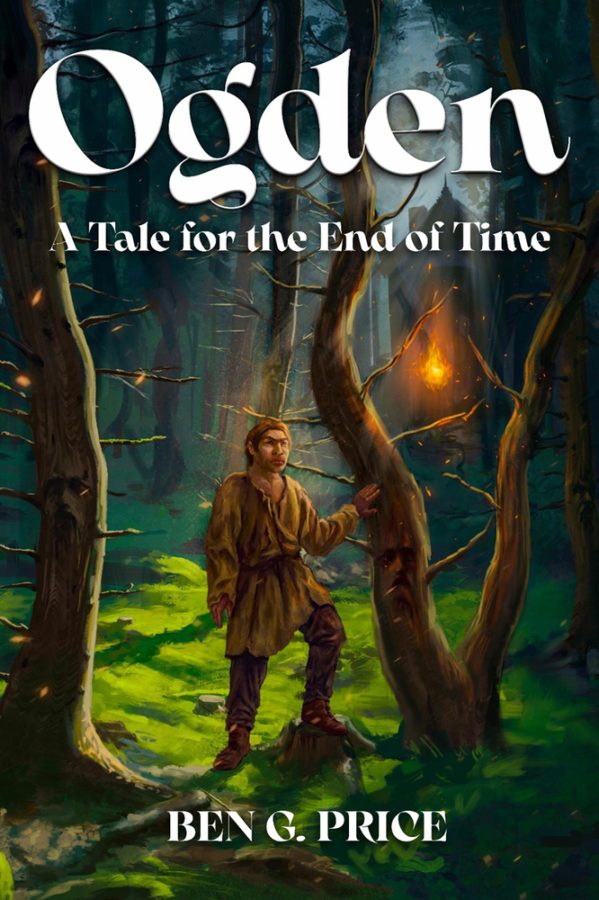Ogden: A Tale for the End of Time by Ben G. Price [Editor’s Pick]
It is rare to read something written from a nonhuman perspective without forcing humanlike qualities on them. Ben Price does exactly that in “Ogden: A Tale for the End of Time.” The shift from human’s to troll’s to bear’s to deer’s perspectives seems authentic and genuine. This reflects the author’s own values: of the author being able to view the nonhumans with respect and see the nuances and complexities of their lives, without attributing humanlike qualities to them. It quite fits the author’s profile as well. Ben Price is a pioneer of the Rights of Nature movement – a movement for legal recognition of the rights of natural entities to survive and thrive, a movement that is not possible with a human supremacist attitude.
The lively forests of Huth and Tibbs
Ogden is a magical coming of age story about a troll who is raised by a human family in a society where men secretly meet to plan the genocide of trolls. Unfamiliar with all of this, the family takes care of the troll and attempts to teach him to become more “civilized”, or more man-like. The book is full of multiple themes, reflecting the unfortunate realities of our society – from patriarchy to class division to human supremacy to racism. It has something for all of us who critique one or more aspects of human society. In this review I’ll explore some of these in the context of the different settings presented throughout the novel.
From Drowden Erebus’ bucolic Hapstead Manor to the wild and lively forests of Huth and Tibbs (Ogden’s troll parents) to the un-lively walled town of Irongate to the slum-like settlement of Doltun and Petula, Ben Price jumps from one setting to another without creating an unsettling feeling among the readers. The four settings describe a contrast of social structure, in terms of class divide, racism, human supremacism, patriarchy, colonialism, a contrast that is not just apparent, but, sadly, too familiar to the readers. Taking a different perspective, these four settings are not just four different social structures but a metaphor to different historical times: the wild forests represent the past where we (all creatures including humans) came from; Hapstead Manor the sedentary lifestyle based on agriculture; Irongate as the industrialized cities, ones that the agriculturalists covet; the slums the inevitable byproducts of the cities.
Price puts our modern society in contrast to egalitarian societies
The societal structure inhabited by trolls, like Huth and Tibbs, is based on respect, not only for nature and natural elements, but for fellow conspecifics, for the females of their species and for other species. For one attuned to it, symbols of matriarchy are apparent in Huth and Tibbs’ cave: ancestor worship and Goddess figurines. Consistent with our most reliable knowledge of matriarchal societies, the trolls are also the most egalitarian of the different characters we see.
While the Hapstead Manor is owned by a kind, loving man who treats his women and children and workers well, it is still “owned” by the man of the house. Ultimately, his words are the last, even though Ben Price describes some instances where the wisdom of Drowden’s worker Argis, cook Odelia, wife Dorina or daughter Miranda prove to be superior to Drowden’s judgment. In other words, they have a significant place in the plot.
The same cannot be said for Irongate. Irongate is ruled, apparently and latently, by a group of belligerent entitled men whose sole purpose in life seems to be to increase their wealth and ultimately their power and to protect their supremacy. They are ready to use any means to do so, including silencing, raping or murdering those who don’t comply. That they rationalize their actions with absurd reasoning can be pitied, but not justified.
Finally, the slum-like settlement (Bladicville) where the outcasts live is an inseparable part of the walled town of Irongate. Cities are designed in a way where the land does not support the population, thus the need to import food from villages. At the same time, cities also require jobs risky enough or “low” enough that the residents do not deign to perform, thus a need for a “lower” group of people to do those jobs. That’s how poor quarters or slums are required in a city. This is where the “lower” group of people find their residence. Poverty is not the only thing that classifies them as inferior.
Humans are enslaving trolls
As Americans should know from their own history, in order for slavery to be justified, the slave owners and traders first needed to believe Blacks to be inferior to Whites. Similarly in “Ogden”, there needs to be created a classification where one group of people is considered inferior to the other. This is implied in the historical background of Ogden with the slavery of trolls by humans. Even though the slavery had ended, the hierarchy thus created, of trolls being an inferior group, was still intact. Slum dwellers like Doltun and Petula were ostracized not just because of their poverty, but because they were half trolls and half humans – a group considered inferior based on their genetic association with trolls.
The book resonates with anyone who grieves over the loss of natural world. I would highly recommend it to our readers.
Ogden: A Tale for the End of Time will be released on October 24th. You can find the book at Addison and Highsmith Publishers.

